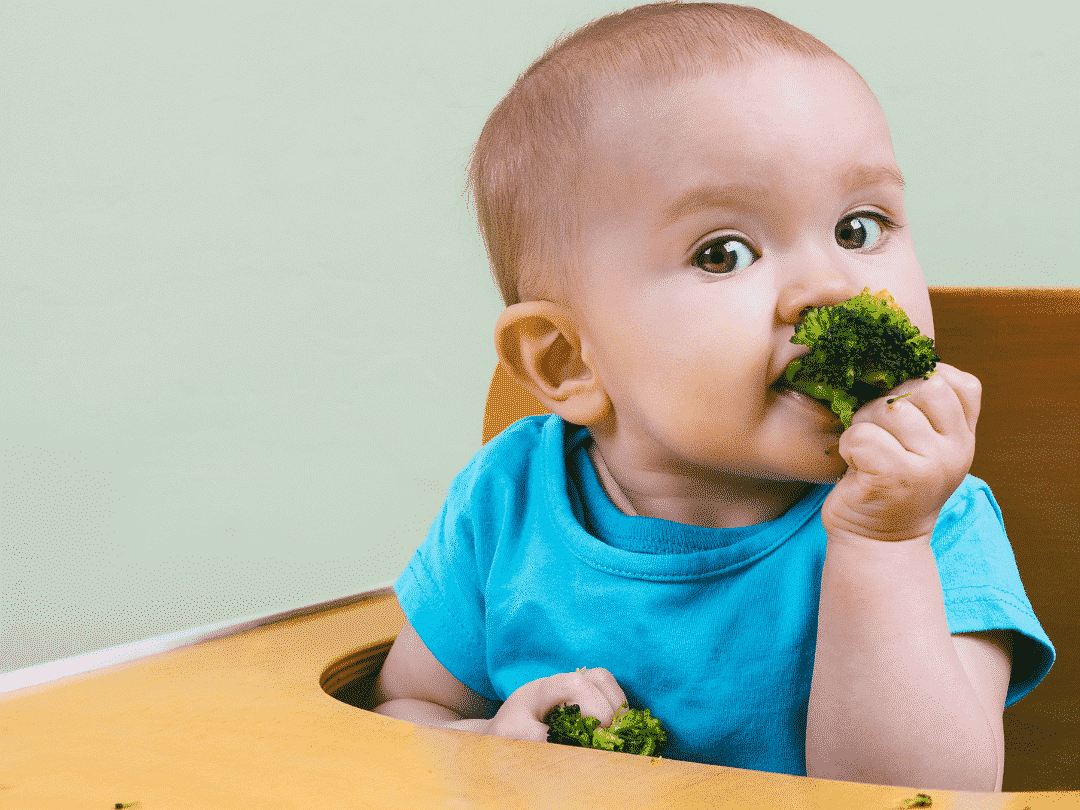Have you witnessed the wars between the baby led weaning parents and the puree parents? Wondering which team you should join? Is one really that much better than the other?
Not really. As with most things, it really comes down to what works for your family. What many people won’t tell you is that you can actually (safely) do a combination of both baby led weaning and purees.
No matter how you start feeding your child, your goal should be to get them onto a wide variety of flavor and textures by about 9 months. Research has shown an association between children who do not receive a variety of textures by this age and picky eating.
This post may contain affiliate links and when you click on the links I may earn a small commission at no charge to you. As an Amazon affiliate, I earn a commission from qualifying purchases.
Baby Led Weaning

In simple terms, baby led weaning skips purees and offers finger foods right from the start. Parents should wait until the baby is developmentally ready to self-feed and then modify the family foods to be an appropriate shape and texture for the baby. There is no increased risk of choking with baby led weaning as long as the parents know how to properly serve foods, which is why I have an entire section dedicated to preparing foods in my Starting Solids Made Easy Course.
Pros
- Baby is self-feeding so they are more in control of what they are eating. They are less likely to be overfed.
- More likely to experience responsive feeding, because they are self-feeding.
- Because they are less likely to be overfed, they are at less risk for becoming overweight.
- Baby will learn how to self-regulate and self-pace their meals.
- Solids are usually introduced later which means a longer time exclusively breastfeeding or bottle feeding.
- Reported decreases in picky eating, likely due to increases in variety.
- Baby eats foods more similar to what the rest of the family is eating. They will be more used to flavors and spices that the family routinely uses.
- There is no need to pack special baby food. Baby can eat whatever the family is eating (with modifications).
Cons
- Very dependent on parent’s nutritional knowledge. Parents need to know which nutrients to include and avoid.
- Babies are more likely to be underweight than babies who are fed pureed diets.
- Babies may be offered foods that are considered high risk for choking due to a lack of knowledge.
- Parents may not offer appropriate foods to meet all of baby’s micronutrient needs (specifically iron).
- There is an increased risk of choking when inappropriate foods are offered.
Many of the “cons” can be remedied by parental education. This is why I do what I do! I keep my Starting Solids Made Easy Course as affordable as possible so that parents can have access to quality education to safely feed their babies.
Purees

Purees are considered the “traditional” way to introduce solids. Generally, you start with a smooth consistency and gradually increase the texture variability until the baby is ready to handle finger foods. In most cases, the parent is spoon-feeding the baby until the baby starts on finger foods.
Pros
- Can purchase nutritionally-complete meals.
- Easy to get a variety of foods in a puree that you may not be able to offer in solid form due to seasons or location.
- Many purees come shelf-stable, so you can store them or easily pack them in a diaper bag.
- Family, friends, and daycares may feel more comfortable offering purees.
- Easier to determine how much baby is eating.
Cons
- Pre-made purees can be expensive and making them yourself can be time consuming.
- More likely to over-feed baby and override baby’s satiety cues.
- If baby does not advance past purees by 9 months, there is an association with increased picky eating.
- Baby doesn’t see the food in it’s true form. May not recognize certain foods once served as finger foods.
- Many baby foods are bland. Research supports introducing babies to a wide variety of flavors in the first year.
Can you do purees and baby led weaning?
There is absolutely no reason why you cannot do a combination of baby led weaning and purees. In fact as adults, we eat pureed textured foods all the time. With combination feeding, it can be helpful to let your baby self-feed the purees as well as the finger foods. Fair warning, it will be messy.
You can offer them a preloaded spoon and let them bring that to their mouth. You can give them a utensil like this gootensil and let them try to get the pureed food out of a bowl by themselves (which is great practice). You can also let them eat with their hands! That is an AMAZING sensory experience for your baby.
So which is best?
It really depends on your unique situation. As I always say, what works best for your family IS best for your family. Often times, the baby will take charge. Put them in their high chair and follow their lead. They may decide that they are self-feeding no matter what you do or they may need to stick with purees a little longer to get the hang of things. Each child is different and that’s why there’s never a “best” when it comes to feeding.

Krystyn Parks is a Registered Dietitian and Lactation Consultant who specializes in feeding children. She has a Master’s Degree in Nutritional Science from California State University Long Beach. She is an International Board Certified Lactation Consultant and has been registered with the Commission on Dietetic Registration since 2013.
